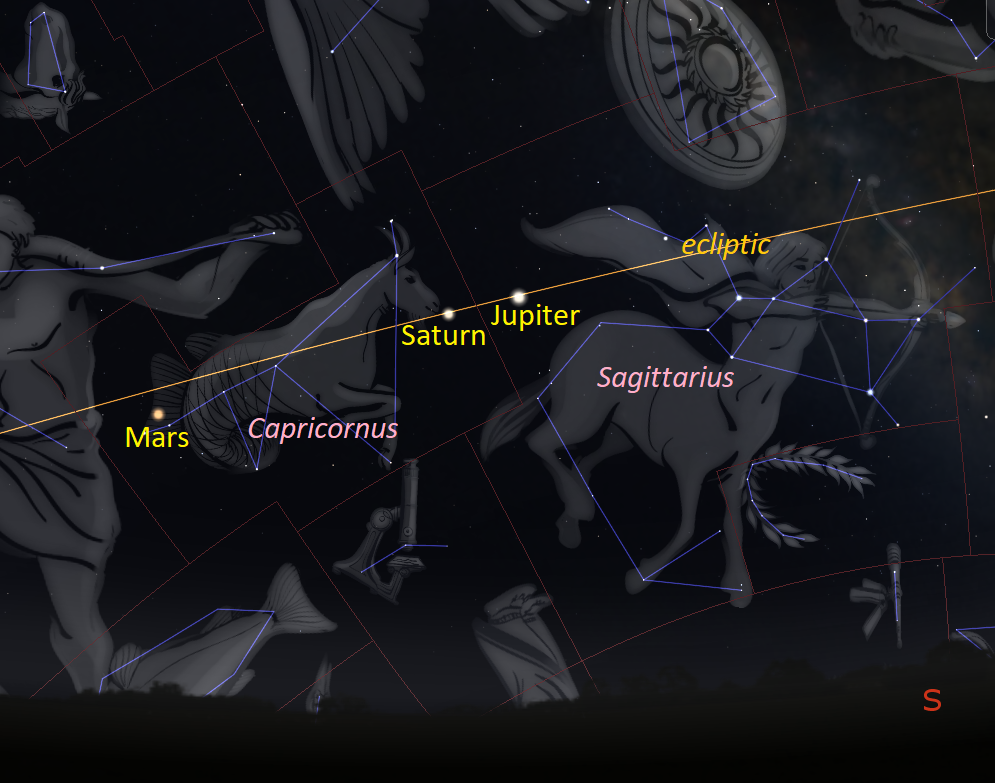The scientific reason you should know the constellations of the zodiac
May 5, 2020
By Amy Sayle
“Where’s Pisces?” “Where’s Cancer?”
In our Carolina Skies planetarium shows, audience members often request that we point out specific constellations, but we get questions about only a fraction of the 88 constellations.
Hardly anyone ever inquires, for example, about the many bizarrely named constellations best seen from the southern hemisphere. (Just once, I’d love for someone to ask about Antlia the Air Pump.)
In my experience, three categories of constellations get all the love:
- Ones that people know from Greek myths, such as Orion and Pegasus
- Ones that people associate with Harry Potter characters, such as Draco
- Ones that people associate with the zodiac, such as Aries, Taurus, Gemini, etc.

That last category is especially popular. Twelve of the 13 (yes, 13) zodiac constellations get asked about way more often than any of the other 76 constellations.
Usually the questioners want us to identify the zodiac constellation they think of as connected with their birthdate, astrologically speaking. Over the year, the Sun appears to trace out a circle in front of the other stars. This apparent annual path of the Sun is called the ecliptic, and it passes through the zodiac constellations. You might reasonably assume that on the date of your birthday, the Sun appears to lie in front of the stars of “your” zodiac constellation.
But astronomically speaking, those dates are wrong. (See a comparison table of dates here.)
For starters, the Sun doesn’t take exactly one month to work its way across each of the 12 astronomical constellations that are associated with astrological signs. To astronomers, constellations are not connect-the-dot outlines or pictures, but entire areas of the sky. Constellations are like interlocking puzzle pieces; everything in the sky can be considered to be part of some constellation.
Virgo, for example, is the second-largest of the 88 constellations by area, and it takes the Sun a long time, more than 6 weeks, to cross that part of the sky. But the Sun just clips the northern edge of Scorpius, cruising through that constellation in only 8 days.
Then there’s the often overlooked constellation of the zodiac, Ophiuchus the Serpent Bearer, which the Sun spends the first 18 days of December passing through.
A further issue with the dates is that Earth’s axis of rotation precesses like a spinning top that’s wobbling. A consequence of Earth’s precession is that the dates that the Sun appears to be in front of particular stars will change over long periods of time—and the astrologers set up their system quite a long time ago.
The Sun, of course, doesn’t actually orbit Earth over the year. It’s Earth that orbits the Sun. So the ecliptic represents Earth’s orbital plane. Because all planets in our solar system orbit the Sun in roughly the same plane as Earth, that’s where you’ll find planets in the sky: on or near the ecliptic, and thus in or near a zodiac constellation.
This brings us to the scientific reason for why you should learn the constellations of the zodiac: to find planets.
If you’re looking in the area of the zodiac and you see a star-like object that’s fairly bright, and that’s shining steadily, and that doesn’t look like it belongs (that is, you don’t always see it in Scorpius, for example), then you’re almost certainly looking at a planet.
The planets appear to move relative to the background of the stars, but currently (early May 2020), you will see Venus in the western early evening sky in the constellation Taurus, and in the southeastern pre-dawn sky you can find Mars and Saturn in Capricornus and Jupiter in Sagittarius.
To help you with your planet hunting, check out our star map for April/May 2020. Once it’s safe to gather in person again, we’ll be delighted to see you at planetarium shows and help you identify whatever most interests you in the sky, whether it’s Pisces, Cancer—or Antlia.
Learn more about the sky in our Morehead At Home: Skywatching sessions. Tune in live each week on Tuesdays and Thursdays at 10 a.m. Eastern time or check out the recorded versions later on YouTube.
